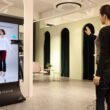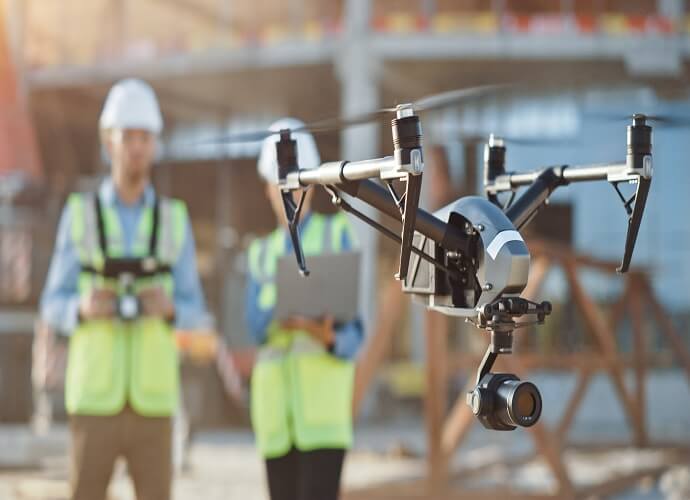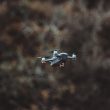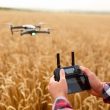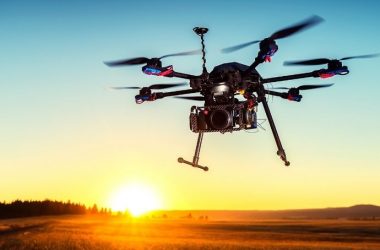Commercial drone uses are transforming the traditional legacy systems for businesses and industries, paving the way for intelligent AI-powered operations for increased productivity.
For most people, unmanned aerial vehicles (UAVs) or AI drones are either a complex military technology or an entertainment tool for hobbyists that enable them to capture breathtaking videos and footage of natural landscapes, sporting events, or urban landscapes. However, today, the primary users of drone technology are businesses and industries utilizing this smart technological tool to create better and more efficient processes. The commercial use of drones goes way beyond simple surveillance or footage; rather, commercial drones are transforming industries altogether. In the Insurance Industry, the commercial use of drones enables companies to inspect damaged assets faster and more efficiently. In the agriculture industry, the drones’ commercial use enables farmers to manage farms efficiently and collect crucial crop data in real-time. These are only a few of drone commercial use examples, and innovators are increasingly reinforcing the capabilities of drones for commercial use across all industries and technologies.
The United States has remained the key player in the development and use of commercial drones. The drone industry in the United States has grown from $40 million in 2012 to over $2 billion in 2018. The overall market for commercial drone stocks to buy in the United States is estimated to reach up to $46 billion in the next five years.
However, as can be expected by all new industries, it is rational to expect some unexpected turns in this growth. Currently, investment in the commercial drone market is soaring, with international giants and conglomerates pooling their funds for the next generation of commercial drones. Air taxis, for instance, is one of the most promising and heavily invested technology for next-generation drone commercial use. And while the technology is still in the early stage of development, the massive potential and high acceptance in industries are already paving the way for further investment and faster development of the technology. The few hurdles that may seem likely to appear as drone commercial use technology matures over the years include regulatory approvals and a lack of infrastructure. Regulatory approval will remain a key barrier as globally; the governments don’t seem in the mood to rubber-stamp large drones taking unpiloted flights. Also, it will be interesting to see cities’ responses to building adequate infrastructure for takeoffs, landings, and storage of commercial drones. Nonetheless, Machine learning technology for commercial drones is here to stay and holds much potential for the future.

How do Commercial Drones work?
While operating drones seems nothing out of the ordinary, the technology itself is quite perplexing and complex. Behind the interactive interface with a joystick, a whole lot is going on with different technologies acting in synchronization to make the flight happen. Some of the key technologies that go being the working of commercial drones include:
Connectivity
Controlling these “flying robots” through a smartphone or tablet may seem easy and fun; however, to enable this seamless connectivity, the drones are equipped with wireless connectivity that enables remote pilots to get a birds-eye view from drones. Modern-day AI-powered drones also come with pre-programmed GPS coordinates that can be utilized to design an automated flight path for the flight. Moreover, wireless connectivity also enables users to monitor battery charge in real time.
Rotors
Commercial drones rely on rotors to control its vertical motion. The rotors found in the drones include propellers which are attached to a motor (used for the hovering), which enable drones to generate a downward thrust equal to the earth’s gravitational pull, as well as, generate greater thrust to climb up against the gravity or generate lower thrust for descend or decrease speed. For drones to hover, two out of the four rotors found in the drones move clockwise, whereas, the other two moves counterclockwise to keep the drones balanced.
Accelerometer and Altimeter
Other important components for the working of commercial drones are the accelerometer and altimeter that control the speed, direction, and altitude of the drone. These features play an important role during the drone flight, as well as, for safe landing of the drones; preventing it from a crash by sinking into the “Wash” unpredictably.
Cameras
Apart from these important technical components that control the flight operations of commercial drone, another key component that adds the utility and versatility to the drones are the cameras. While most commercial drones come with a built-in camera that enables remote pilots to monitor the direct line of sight, others may allow you to integrate imaging sensors of your choice as payload. When we talk about the drones for commercial use, these aren’t just used to get the photos of remote locations or catch a great birds-eye view of the landscape, rather these are also used for industrial and commercial activities. For instance, farmers may add infrared or thermal scanner as payloads to the drones for mapping crop health and soil fertility. Similarly, night time cameras may be integrated with drones for border surveillance and other purposes.
Folio3 is Your Best Commercial Drones Tech Partner
Folio3 is a leading technology service provider for AI-powered commercial drones. The company has been developing intelligence commercial drone technology to assist businesses and industries from different verticals. From agriculture to terrain mapping and livestock management, Folio3 intelligence AI-powered commercial drone technology is enabling industries across the globe to improve their workflow processes and increase the efficiency of legacy procedures.
The robust AI drone technology solutions from Folio3 is used for:
Aerial Data Collection
Enable businesses to deploy various types of imaging sensors, including cameras, thermal sensors, LiDAR, multispectral sensors, and others to get real-time scientific data for commercial and scientific use such as ai drone solar panel inspection.
Data Analytics
Powerful machine learning, AI, and computer vision algorithms offered for faster and efficient interpretation of data to support competent commercial practices such as terrain mapping.
Delivering Action
Intelligence drones applications build to takeover tedious and time-consuming tasks like surveillance to data analytics and harvesting seeds such as livestock management.
Drones Commercial Use in this Era
Drones have come a long way from their initial concept of working as military reconnaissance tools. Today, drones for commercial use are pushing the technology to new frontiers enabling more possibilities for these flying robots to improve efficiency and processing of various industries. Below are some of the key industries and applications utilizing drones for commercial use;
Entertainment
Today the entertainment industry is one of the biggest users of commercial drone technology. From films to television, the industry is pushing drone technology to limits to generate stunning and breathtaking shots. Disney has already filed the patent for a drone support light system, which will be used to recreate the bright lit sky from Tangled. The recreated scene would use drones to mimic thousands of lanterns lighting the night sky. The industry also got plans to use commercial drones for aerial light displays. All of this will open up more opportunities for commercial drones in the entertainment industry.
Advertising
The entertainment industry isn’t the only media-related industry that has been exploiting the benefits of commercial drones. The advertising industry is also on par with the entertainment industry when it comes to utilizing the flying robots to create some amazing and innovative advertisements. Advertisement agencies across the world are already using drones carrying promotional banners as the next big thing in the industry. Moreover, companies are using drones to airdrop promotional merchandise in concerts or other public events. And this is only just the beginning.
With powerful AI drones, the technology can be used to project commercials or images across courtyards, or sidewalks as an affordable and greener alternative to spot advertising. The technology can also be used by restaurants and hotels to flow out product samples to passerby on the streets.
Emergency Response
Apart from the entertainment and media industry, commercial drones are also being used excessively as emergency responders. As the technology matures and large commercial drones become readily available in the market, it is becoming possible for emergency and rescue workers to send in drones as emergency responders with first aid kits or other humanitarian services. Government agencies across the world have deployed AI-powered commercial drones in various rescue roles including searching for survivors from natural disasters to disbursing emergency goods to people stuck in disaster-hit areas. The latest Defibrillator drones today are enabling medical emergency responders to reach out faster to victims of heath attacks and save precious lives. Overall, the use of commercial technology as the emergency responders are improving the chances of survival for the victims, without putting the first responders at risk.
Agriculture
Moving on, next in line we have the agriculture industry as one of the big users of commercial drones. The industry has been utilizing drones for various purposes from reconnaissance surveys for field monitoring t/99o crop health monitoring and now also experimenting with commercial use of drones for seeding and spraying. Commercial drone technology is been projected as the next big thing in the agriculture industry that is crucial to keep up with the increasing demand for food to feed the ever-increasing global population.
Logistics
Last but not least we have one of the latest avenues for which the feasibility and viability of commercial drones are still tested. Tech giants like Amazon have already deployed drone fleet for faster and more efficient delivery of orders in the United States, and while this is still a relatively new role for commercial drones, the speed at which it is being adopted in the industry says a lot for the promising future of commercial drones in this sector as well.
History of Drones for Commercial Use
While the history of drones itself is quite old and maybe dated back to World War 1, where they were first used as military tools meant to capture crucial information behind the enemy lines. The commercial use of the drones didn’t start till 2006, the year when the Federal Aviation Administration issued the first commercial license for drones.
Initially, the commercial drones were tested for their capabilities in disaster and rescue operations or border surveillance, however, slowly but surely these flying robots proved their worth as the futuristic technology that will define the modern-day business and industrial practices.
7 best Commercial Drones with Cameras
1) DJI Mavic 2 Pro
Camera: 20MP, 4K
Battery Life: 31 Minutes
Potential Industry Use: Film making, Construction, Marketing
The DJI Mavic 2 Pro is the latest generation of camera drones from DJI – a leading manufacturer of commercial drones. The Swedish manufacturer is known for its exceptional quality professional-grade camera drones. This flying machine has a 20MP camera with advanced HDR and color sensitivity.
Another brilliant feature of this drone is its omnidirectional obstacle sensing capability that enables it to sense obstacles from five directions (right, left, backward, forward, and downward), making it the perfect tool for use in various industries including; marketing, construction, and filmmaking.
2) DJI Phantom 4 RTK
Camera: 20MP, 4K
Battery Life: 30 minutes
Potential Industry use: Construction, GIS surveying
Next in line, we have yet another entry from the DJI, this time around with its DJI Phantom 4 RTK visionary drone. The RTK capability of the drone enables it to create a real-time aerial mapping, which opens up many new commercial uses for the drone. The drone has a brilliant 20MP camera with a CMOS sensor for capturing high-quality images.
Another unique feature of this flying machine is the DJI GS RTK app, which enables users to program the drone for an intelligent flight with terrain awareness, waypoint flight, and 2D & 3D photogrammetry for professional aerial mapping.
3) DJI Inspire 2
Camera: Compatible with multiple cameras from Zenmuse
Battery Life: up to 27 minutes
Potential Industry Use: Filmmaking
This inspiring flying machine from DJI is specifically meant for filmmakers and cinematographers, looking to create stunning Hollywood camera quality films with limited resources. The drone is equipped with smart sensors and made with premium materials and an aesthetically pleasing design; making it an ideal platform for cinematography. The magnesium-aluminum construction and carbon fiber arms of the drones enable it to offer an unmatched 360-degree view.
4) Freefly Alta 8
Potential Industry Use: Filmmaking
The next in line for our top commercial drones is an amazing machine that is specifically meant to offer unparalleled cinematography experience for filmmakers and video enthusiasts. This amazing piece of technology is a marvel in its ability to carry as much as a 20-pounds payload, which can be mounted either on top or at the bottom. The octo-rotor drone comes with a weather-resistant plastic enclosure makes it the perfect choice amongst cinematographers looking to film amazing shots in a multitude of climates.
5) Flyabilty Elios 2
Camera: 12 MP
Battery Life: 10 minutes
Potential Industry Use: Indoor Inspections
Flyability is an engineering marvel that transformed the way drones are used for indoor inspections. The drone comes with amazing configurations that include a spherical cage encaging the entire payload while keeping the overall dimensions under 40cms, which can be fit in any space. The powerful transmission system of the drone is able to work seamlessly beyond the line of sight, which enables it to operate without any interference from concrete walls, steel structures, or other obstacles.
6) DJI Agras MG-1
Battery Life: 24 minutes
Potential Industry Use: Agriculture
Next, we have yet another amazing drone from DJI; this time the octocopter DJI Agras MG-1. This is an exclusively manufactured drone for precision agriculture, which enables farmers to automate various traditional practices like spraying pesticides or fertilizers. The robust and powerful propulsion system of the drone enables it to complete the task up to 60 times faster than manual spraying, with a liquid holding capacity of up to 10 Kgs. The smart spraying mechanism can be controlled remotely to adjust the dispersed liquid based on the speed of the drone, to ensure even application every time.
7) SenseFly eBee Classic
Camera: 20MP
Battery Life: 50 minutes
Potential Industry use: GIS & Surveying
This is a fully-autonomous fixed-wing drone that is meant to capture high-quality aerial imagery for land surveying and 3D terrain modeling. The flight path can be preprogrammed and no prior piloting skills are required to operate the flight. The fixed-wing configuration makes it highly aerodynamic and ideal for use in aerial surveying of large areas.
Large Commercial Use of Drones Benefits and Advantages
Large commercial drones have transformed various industries; enabling faster and efficient workflow processes and operations for increased efficiency. Some of the benefits of commercial drones include:
Environment friendly
Cost-effective
Access to remote places
Efficient and faster processes for business growth
FAQs:
Who makes drones for commercial use in enterprises and SMEs?
Some of the biggest manufacturers of commercial drones include;
Lockheed Martin
DJI (Dajiang) Innovations
GoPro
Ambarella
3D Robotics
Boeing
Parrot SA
Yuneec
Autel Robotics
Hubsan
Why commercial drones are bad for a beginner?
Commercial drones are relatively expensive as compared to small hobbyist drones, which cost at an average from $10,000 to $25,000 or more. These are exclusively built for specific applications and may require prior piloting skills for effective use. Any fault in piloting these drones may damage drones, which in most cases will leave it unusable.



